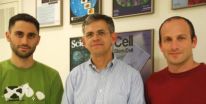(Press-News.org) Jerusalem, November 21, 2010 – Research work carried out at the Hebrew University of Jerusalem arouses a cautionary warning in the growing field of the development of stem cells as a means for future treatment of patients through replacement of diseased or damaged tissues by using the patient's own stem cells. The research indicates a possible danger of cancerous tissue development in the use of such cells.
Embryonic stem cells, which are undifferentiated cells, have the potential to develop into all cell types of the adult body, and thousands of researchers all over the world are working to develop the techniques which will make possible their eventual application.
Research in the field has been carried out initially using embryonic stem cells taken from human embryos. However, a breakthrough occurred when, a number of years ago, Japanese scientists succeeded in creating embryonic-like stem cells from mature human cells through an induced "reprogramming" process. This made it possible to obtain stem cells from a patient which can be used in his or her own treatment, thus avoiding the possibility of cell rejection. These cells are called induced pluripotent stem (iPS) cells.
In order for stem cells to be used in the clinic, however, they must be raised in cultures for an extended period. During this period, it has been observed that embryonic stems cells underwent chromosomal changes, which included changes that characterize cancerous tumor growth.
Research that has been carried out in the laboratory headed by Nissm Benvenisty, the Herbert Cohn Professor of Cancer Research at the Silberman Institute of Life Sciences at the Hebrew University of Jerusalem, has now shown that the iPS cells also undergo abnormal chromosomal changes in culture.
Prof. Benvenisty, together with his post-doctoral fellow Yoav Mayshar and his doctoral student Uri Ben-David, developed a new analytical method for determining the genetic structure of the chromosomes in the iPS cells through determining the cellular patterns of gene expression.
Each cell generally bears two copies of each chromosome in the genome. The Hebrew University researchers discovered that, in time, three copies of chromosomes (trisomy) began to appear in the culture, and that the cells with the extra chromosome were able to rapidly overpower the other, normal cells in the culture. Such trisomies are present in abnormal tissue development, including cancerous growths.
The researchers examined over 100 cell lines which were published by 18 different laboratories around the world, in addition to the iPS cultures raised in their own laboratory, and in this way were able to solidly verify a great number of chromosomal changes in cell lines that until now were considered normal.
In an article published in Cell Stem Cell journal, the Hebrew University researchers have reported their discovery. They noted that the chromosomal changes were not incidental, but rather appeared systematically on chromosome 12 and involved up-regulation of specific genes which reside on that chromosome. This discovery is liable to hinder progress on the development of the use of human iPS cells in future therapy because of the tumorigenic danger involved.
"Our findings show that human iPS cells are not stable in culture, as was previously thought, and require reassessment of the chromosomal structure of these cells," said Prof. Benvenisty. "Also, our work shows for the first time the gene expression changes that accompany these chromosomal aberrations found in the culture, paving the way for our beginning to understand the mechanism by which these changes occur.
"The chromosomal changes in these iPS cells require everyone to exercise great care in continuing to work with them, since these changes apparently will influence the differentiation potential and the tumorigenic risk of these cells."
According to Prof. Benvenisty, "The method we have developed for identifying chromosomal changes through gene expression is likely to serve also in other work involving analysis of different kinds of cells, including cancer cells. It is relatively simple to use and enables one to observe the changes without having to directly analyze the DNA of the cells." The discovery is patented by Yissum, the Technology Transfer Company of the Hebrew University of Jerusalem, which is currently searching for commercial partners for further research and development.
INFORMATION:
Hebrew University research carries cautionary warning for future stem cell applications
2010-11-23
ELSE PRESS RELEASES FROM THIS DATE:
Genes link sexual maturity to body fat in women
2010-11-23
An international group of scientists, including researchers at the Medical Research Council (MRC), has discovered 30 genes that control the age at which girls reach sexual maturity. They found that many of the genes responsible for puberty also play a strong role in how the body metabolises fat, establishing new biological links between going through puberty at a young age and being at increased risk of obesity.
This knowledge will help to explain why girls in some families are more likely to go through puberty at an early age, and may eventually help to prevent chronic ...
Scientists call for protection of Australia's subtropic seas
2010-11-23
Leading scientists and marine managers have called for a greater national effort to protect vital 1000-kilometre stretches of ocean bordering the middle of Australia's eastern and western coastlines.
In a major statement entitled The Coffs Harbour Subtropical Reefs Declaration, they urge increased focus and better management for reefs south of the Great Barrier Reef and WA tropical coral zone, explaining that these more southerly areas are expected to become critical refuges for northern tropical marine life under global warming.
The declaration follows a workshop by ...
Age estimation from blood has immediate forensic application
2010-11-23
"We demonstrate that human age can be estimated from blood with reasonable accuracy using a simple, robust, and sensitive test assay," said Manfred Kayser of the Erasmus MC University Medical Center Rotterdam in the Netherlands. "Our method is applicable in situations where only bloodstains are available, which covers a large proportion of crime cases."
The method will be especially useful in forensic cases in which age information is important to provide investigative leads for finding unknown persons, Kayser added. Existing methods for age estimation have limited use ...
Exercise may improve complications of deep vein thrombosis
2010-11-23
A pilot trial showed that a six-month exercise training program designed to increase leg strength, leg flexibility and overall fitness may improve post-thrombotic syndrome, a frequent, chronic complication of deep vein thrombosis, states a research article in CMAJ (Canadian Medical Association Journal) (pre-embargo link only) http://www.cmaj.ca/embargo/cmaj100248.pdf
Chronic post-thrombotic syndrome develops in up to one half of patients with deep vein thrombosis (DVT). These patients can experience leg pain, heaviness, swelling, water retention, hyperpigmentation and ...
New clinical practice guideline may help reduce the pain of childhood immunization
2010-11-23
A new evidence-based clinical practice guideline will help doctors, healthcare providers and parents reduce the pain and distress of immunization in children, states an article in CMAJ (Canadian Medical Association Journal) (pre-embargo link only) http://www.cmaj.ca/embargo/cmaj092048.pdf.
Immunization injections are the most common source of physician-induced pain in childhood and are given many times to most Canadian children. Pain from vaccine injections needs to be addressed at an early age to avoid needle fears and anxiety at future procedures, and non-compliance ...
New function of gene in promoting cancer found by VCU researchers
2010-11-23
Richmond, Va. (Nov. 22, 2010) – Researchers at Virginia Commonwealth University have discovered that a gene well known for its involvement in tumor cell development, growth and metastasis also protects cancer cells from being destroyed by chemotherapy. By inhibiting the expression of this gene, doctors may have a new viable and effective approach for treating aggressive cancers such as breast, liver and prostate carcinomas, malignant gliomas and neuroblastomas that result from high expression of this cancer-promoting gene.
The new study was reported the week of Nov. 22 ...
Muscle cells point the finger at each other
2010-11-23
A new study reveals that muscle cells fuse together during development by poking "fingers" into each other to help break down the membranes separating them. The study appears online on November 22, 2010 in the Journal of Cell Biology(www.jcb.org).
During muscle development, individual muscle cells fuse together to form long myotubes containing multiple cell nuclei. In the fruit fly Drosophila melanogaster, fusion occurs between two different types of muscle cell: founder cells and fusion-competent myoblasts. Using electron microscopy to analyze developing fly embryos, ...
Flying snakes, caught on tape
2010-11-23
WASHINGTON, D.C., November 22, 2010 -- Five related species of tree-dwelling snakes found in Southeast and South Asia may just be the worst nightmares of ophidiophobes (people who have abnormal fears of snakes). Not only are they snakes, but they can "fly" -- flinging themselves off their perches, flattening their bodies, and gliding from tree to tree or to the ground.
To Virginia Tech biologist Jake Socha, these curious reptiles are something of a biomechanical wonder. In order to understand how they do what they do, Socha and his colleagues recently studied Chrysopelea ...
A divide and conquer strategy for childhood brain cancer
2010-11-23
Boston, Mass. – Medulloblastomas are the most common malignant brain tumors of childhood, with 40 to 50 percent overall mortality. One of the greatest challenges in treating them is that they vary substantially from patient to patient. In the largest genomic study of human medulloblastomas to date, researchers from Children's Hospital Boston, together with collaborators, have identified six subtypes with distinct molecular "fingerprints" that will improve doctors' ability to direct and individualize treatment.
The study, reported online November 22nd in the Journal of ...
Black children more likely to die from neuroblastoma, study finds
2010-11-23
Black, Asian, and Native American children are more likely than white and Hispanic children to die after being treated for neuroblastoma, according to new research on the pediatric cancer. The study, of more than 3,500 patients with the disease, is the largest ever to look at racial disparities in risk and survival for the most common solid cancer found in young children.
The study also found that black and Native American children are more likely to have the high-risk form of the disease and show signs of resistance to modern treatment. Those biological characteristics ...

